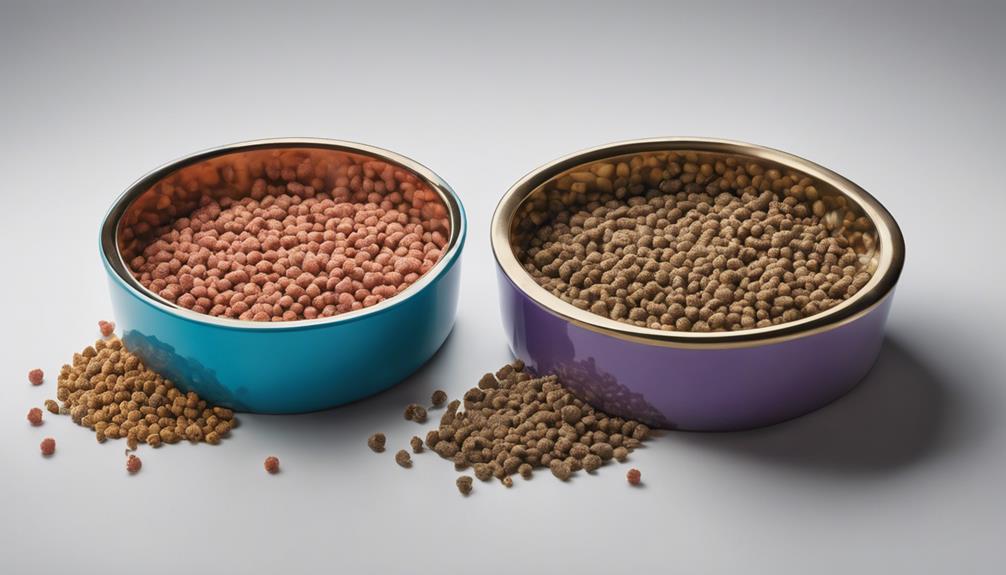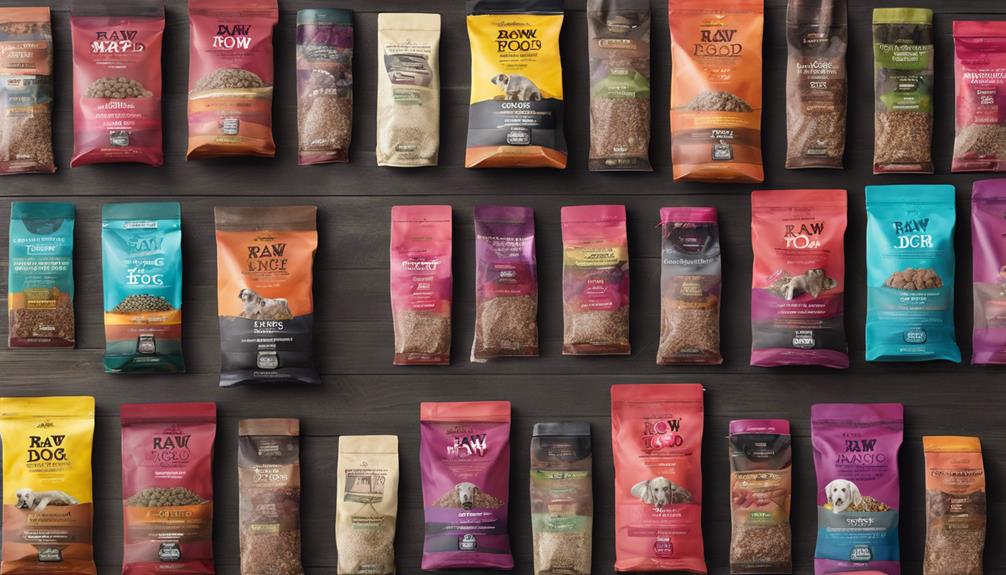When I have to choose between raw dog food and freeze-dried options, it’s important to weigh the advantages and disadvantages of each. Raw dog food provides dense nutrition that mirrors the natural diet of canids, which can benefit skin, coat, and immune function. However, there is a risk of bacterial contamination with raw dog food and it requires careful handling. On the other hand, freeze-dried dog food retains essential nutrients well, is convenient, and has a longer shelf life. Both options come with health benefits and risks, so evaluating these factors will be crucial in selecting the best option for my pup’s needs.
Key Takeaways
- Raw dog food offers nutritionally dense, natural diet with improved skin, coat, and immune function.
- Freeze-dried food retains essential nutrients, enzymes, vitamins, and minerals effectively.
- Raw food is high in moisture and antioxidants, freeze-dried has essential fatty acids and energy.
- Raw food requires meticulous handling due to bacterial contamination risks.
- Freeze-dried food is convenient, lightweight, with extended shelf life and quick rehydration process.
Pros and Cons of Raw Feeding
When contemplating the pros and cons of raw feeding for dogs, it's crucial to evaluate the benefits of a diet closely aligned with their natural canid diet against the potential risks of bacterial contamination from raw meat.
Raw feeding offers a nutritionally dense option for dogs, providing essential nutrients that can lead to improved skin, coat, and immune function. This diet mirrors what dogs would eat in the wild, potentially enhancing their overall health and well-being.
However, a significant drawback of raw feeding is the risk of bacterial contamination from handling raw meat, which can pose health concerns for both dogs and their owners. Some pet owners may also find raw feeding inconvenient or time-consuming to prepare at home, requiring careful planning and storage to make sure food safety.
It's important to take these factors into account when deciding whether raw feeding is the right choice for your furry companion.
Nutrient Retention in Freeze-Dried Food
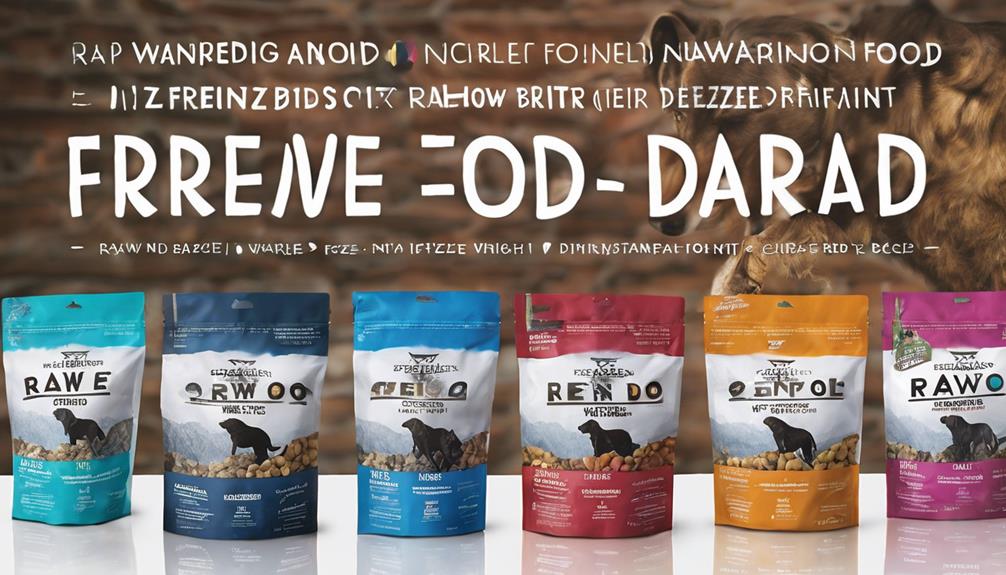
Considering the nutritional advantages of freeze-dried dog food, it's important to acknowledge its superior retention of essential nutrients and enzymes compared to traditional kibble.
The freeze-drying process effectively preserves vitamins, minerals, and enzymes, guaranteeing that your pup receives a diet rich in essential nutrients.
Freeze-dried options offer a natural source of these crucial elements, maintaining the nutritional content of the ingredients.
Both freeze-dried raw and frozen raw choices provide a wide range of essential nutrients and enzymes beneficial for your dog's health.
This method helps to lock in the goodness of the ingredients, offering a convenient way to ensure your furry friend gets the necessary vitamins and minerals in their diet.
The nutrient retention in freeze-dried foods makes them a practical and nutritious choice for pet owners looking to provide their dogs with a balanced and wholesome diet.
Safety Considerations for Raw Food
When contemplating raw dog food, it's vital to be mindful of the potential risks linked to bacterial contamination, like Escherichia coli and salmonella.
Handling raw meat and bones requires strict hygiene practices to prevent foodborne illnesses in our furry companions.
It's imperative to prioritize safe food preparation methods to guarantee the well-being of our pups.
Raw Food Bacteria Risks
Raw dog food carries a significant risk of bacterial contamination, including pathogens like Escherichia coli and salmonella. To minimize these risks, meticulous handling and storage practices are essential. Proper hygiene is critical when dealing with raw food to prevent infections. Freezing raw dog food before serving can help reduce bacterial growth, but it does not entirely eliminate all risks. It is important to regularly clean and disinfect surfaces, utensils, and bowls used for preparing and serving raw food to safeguard against contamination. Below is a table illustrating key points regarding raw food bacteria risks:
| Raw Food Bacteria Risks |
|---|
| Pathogens: E. coli, Salmonella |
| Handling and Storage: Meticulous |
| Hygiene Practices: Critical |
| Freezing: Helps reduce bacteria |
| Cleaning: Regular disinfection |
Handling Raw Meat
Keeping raw meat frozen until ready for use is essential to prevent bacterial growth and guarantee food safety. When handling raw meat, it's important to follow proper procedures to minimize the risk of contamination.
Here are some key points to keep in mind:
- Thaw raw meat in the refrigerator or using cold water, not at room temperature.
- Use separate cutting boards and utensils for raw meat to avoid cross-contamination.
- Wash hands, surfaces, and utensils thoroughly after handling raw meat.
- Discard any uneaten raw meat within a safe timeframe to prevent spoilage and bacterial growth.
Safe Food Preparation
To guarantee the safety of raw food preparation, it's essential to always use separate cutting boards and utensils to prevent cross-contamination.
Thawing raw meat in the refrigerator or under cold water helps maintain safe temperatures, deterring bacterial growth.
After handling raw dog food, thorough handwashing with hot, soapy water is vital to prevent pathogen transmission.
Storing raw dog food in a dedicated area of the refrigerator prevents leaks and contamination of other foods, ensuring food safety.
Prompt disposal of any leftover raw food minimizes the risk of bacterial growth and potential foodborne illnesses, prioritizing the well-being of your furry companion.
Convenience of Freeze-Dried Options
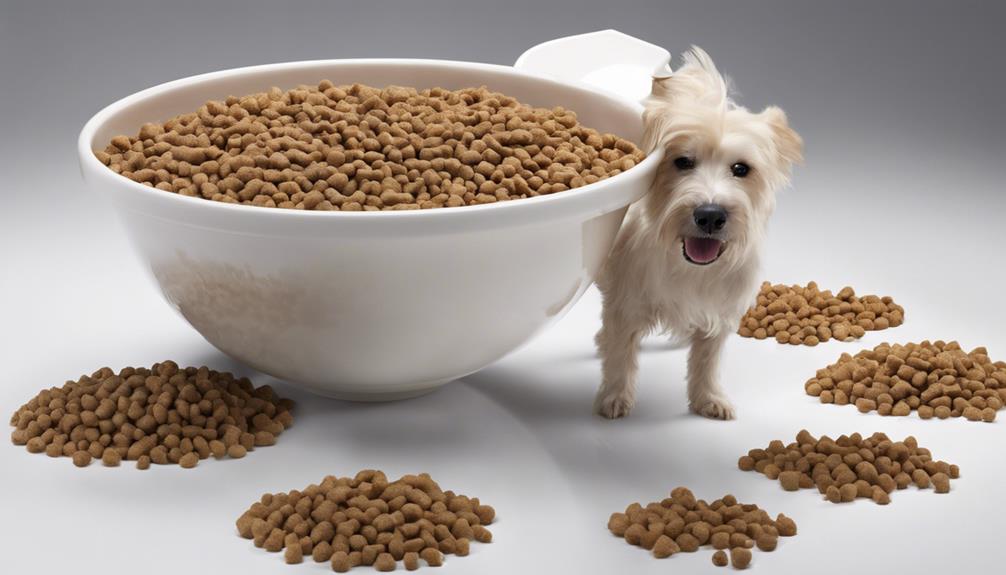
Freeze-dried dog food offers unparalleled convenience for pet owners due to its lightweight nature and extended shelf life. Here are four reasons why freeze-dried options are a convenient choice for your pup:
- Easy Transport: Its lightweight quality makes it a breeze to carry along for travels or outdoor adventures with your furry companion.
- Storage Convenience: Unlike frozen raw food, freeze-dried options don't require freezer space, making it ideal for pet parents with limited storage capacity.
- Extended Shelf Life: With a longer shelf life compared to frozen raw alternatives, you can reduce the frequency of restocking, ensuring you always have pet food on hand.
- Quick Rehydration: The rehydration process for freeze-dried dog food is simple and fast, making it convenient for feeding times and ensuring your pup gets their meal promptly.
These factors make freeze-dried dog food a practical and hassle-free choice for pet owners looking for convenience without compromising on the quality of their pet's diet.
Health Benefits of Raw Dog Food
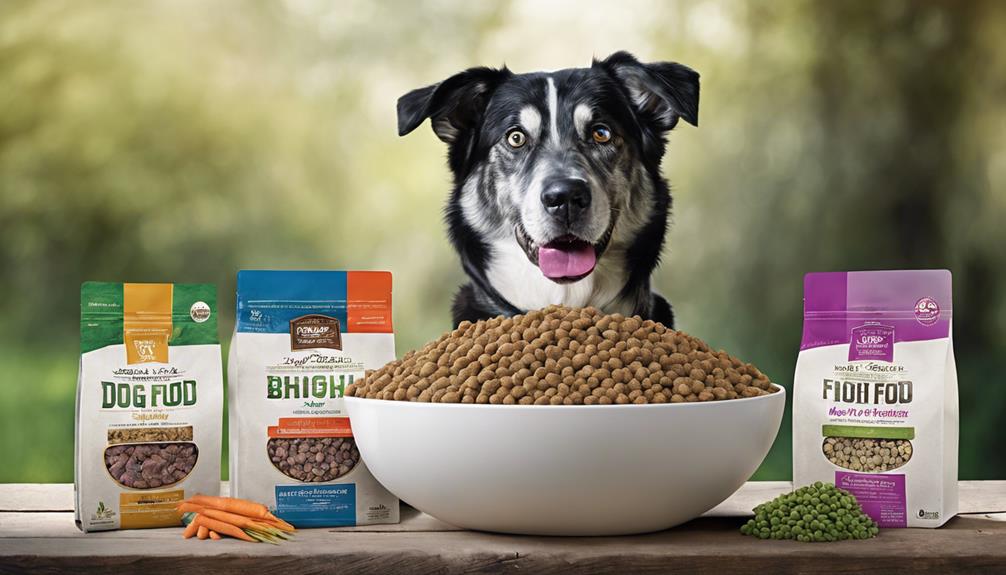
Raw dog food provides numerous health benefits for your pup. These include promoting healthier digestion, enhancing skin and coat health, boosting the immune system, improving energy levels, and contributing to better dental health.
The raw diet's high moisture content and natural enzymes aid in digestion. Essential fatty acids nourish the skin and coat, leaving them healthier and shinier. The immune system benefits from the high levels of antioxidants and probiotics found in raw dog food, helping to ward off illnesses and infections.
Additionally, the essential vitamins and minerals present in raw dog food can increase your pup's energy levels and stamina. Chewing on raw food can also improve dental health by reducing plaque buildup, leading to better oral hygiene and fresher breath.
Embracing a raw diet can greatly enhance your dog's overall well-being, from the inside out.
Bacterial Contamination Risks
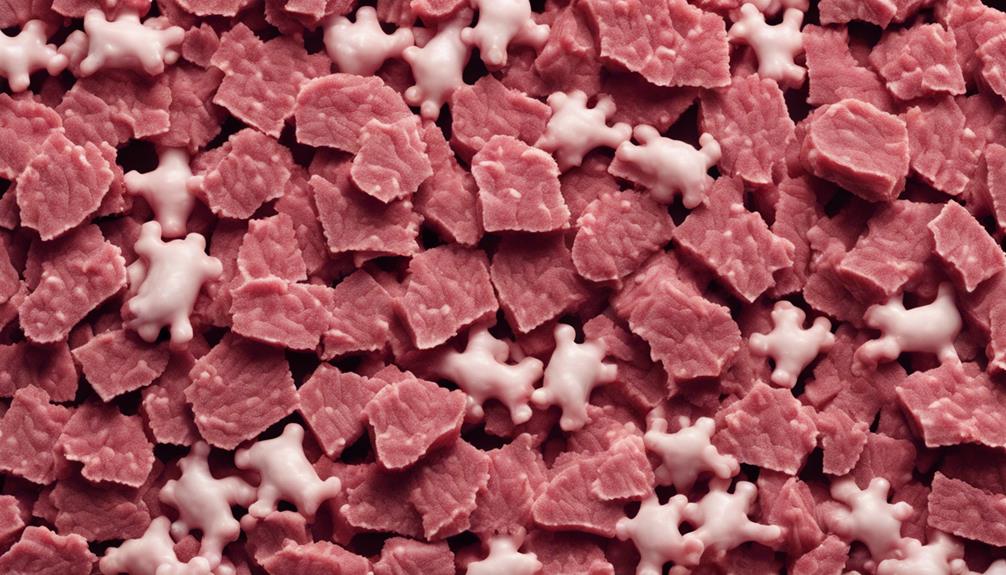
Bacterial contamination risks associated with dog food consumption are a significant concern for pet owners seeking to prioritize their pup's health and well-being.
- Raw diets can harbor harmful bacteria such as Escherichia coli and salmonella, posing health risks to dogs.
- Freeze-dried dog food minimizes bacterial growth by undergoing a moisture removal process that inhibits bacteria proliferation.
- Raw food exposes dogs to potential bacterial contamination, parasites, and choking hazards from bones.
- Freeze-dried dog food offers the convenience of a shelf-stable product while providing similar health benefits to raw food but with reduced bacterial risks.
It is important to take into account these bacterial risks when choosing between raw diets and freeze-dried options for your furry companion. By opting for freeze-dried dog food, pet owners can mitigate the dangers associated with bacterial contamination often present in raw food, ensuring their pup's safety and well-being.
Choosing the Best Diet for Your Pup
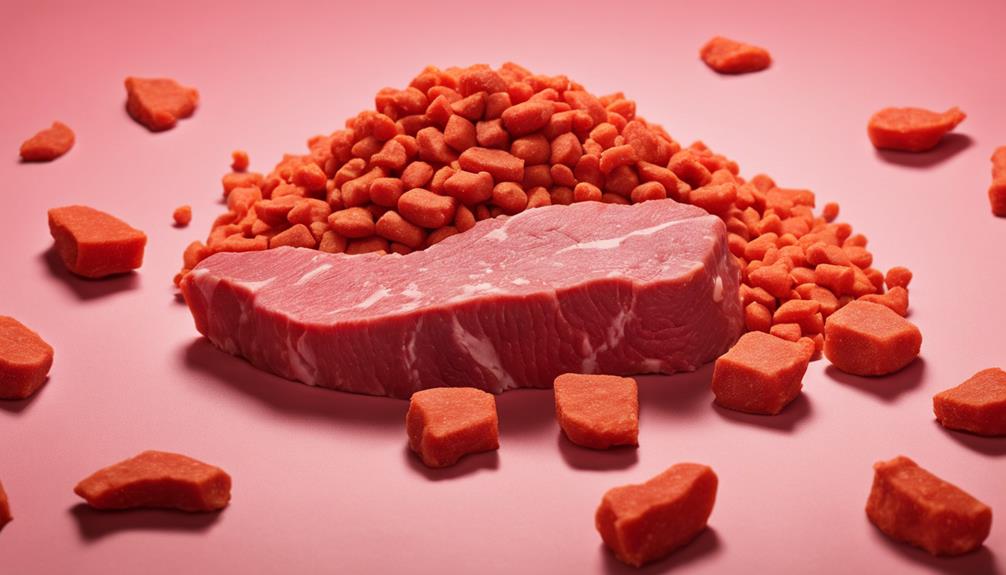
When selecting the optimal diet for your pup, it's essential to evaluate their nutritional requirements and compare the health advantages of various food options.
Consider your lifestyle, convenience preferences, ongoing budget, and the level of effort you're willing to invest in meal preparation.
Ultimately, prioritize what aligns best with your dog's overall health and well-being.
Nutritional Needs Assessment
Considering the specific nutritional requirements of your pup is crucial when determining the best diet option between raw dog food and freeze-dried alternatives.
- Evaluate the protein, fat, carbohydrate, and micronutrient content in each diet to guarantee your pet's needs are met.
- Check the water content, as raw meat contains moisture essential for hydration.
- Consider the shelf life of the food to prevent spoilage and ensure freshness.
- Understand the balance of nutrients each type of food provides for your pet's overall health and well-being.
Health Benefits Comparison
Comparing the health benefits of raw dog food and freeze-dried options can help pet owners make informed decisions about the best diet for their furry companions.
Raw feeding offers high moisture content and natural enzymes for improved digestion, while freeze-dried options provide essential fatty acids for healthier skin and coat.
Raw diets are rich in antioxidants and probiotics, promoting a stronger immune system in dogs. Additionally, frozen raw food contains essential vitamins and minerals that boost energy and stamina.
Both raw and freeze-dried diets contribute to better dental health by reducing plaque buildup through natural chewing. Understanding these health benefits can assist pet owners in selecting the most suitable diet to support their dog's overall well-being.
Frequently Asked Questions
Is Freeze-Dried Food Good for Puppies?
Yes, freeze-dried food is beneficial for puppies. It preserves essential nutrients, aids digestion, and is convenient. It fulfills puppies' nutritional requirements, supports growth, and is easy to feed. Opt for high-quality freeze-dried options for your pup's health.
Do Vets Recommend Freeze-Dried Raw?
Vets often recommend freeze-dried raw food for dogs due to its nutritional value and convenience. It's a safe option that provides essential nutrients. The freeze-drying process preserves natural enzymes and vitamins, making it a healthier alternative to traditional dog food.
Do Vets Recommend Raw Food for Puppies?
As a vet, I don't suggest raw food for puppies due to bacterial risks and nutritional imbalances. Their developing immune systems may struggle with potential pathogens. To guarantee balanced nutrition, consult a veterinary nutritionist or opt for commercial puppy food.
Is Raw Food or Kibble Better for Puppies?
For puppies, I believe raw food surpasses kibble in providing crucial nutrients and promoting overall health. Its natural benefits, akin to a nourishing hug, support immunity, digestion, and vitality, making it my preferred choice.
What Are the Key Differences Between Freeze Dried and Dehydrated Dog Food?
When it comes to raw dog food showdown, the key differences between freeze-dried and dehydrated dog food lie in the moisture content and nutrient retention. Freeze-dried dog food typically retains more nutrients and flavor due to the quick freeze-drying process, while dehydrated dog food may have a higher moisture content and slightly less nutrient retention.
Conclusion
To sum up, when contemplating the optimal diet for your pup, it's important to weigh the benefits and risks of both raw dog food and freeze-dried options.
While both have their advantages, it's essential to prioritize the health and safety of your furry companion above all else.
Making an informed decision based on your pup's individual needs and preferences will guarantee they receive the best possible nutrition for a happy and healthy life.
